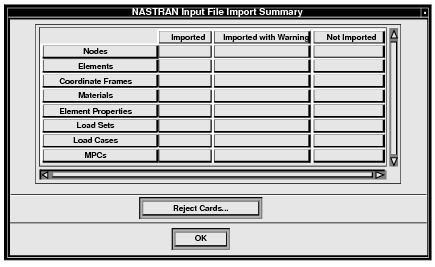XXXXXXXXXXXXXXXXXXXXXXXXXXXXXXXXXXXXXXXXXXXXXXXXXXXXXXXXXXXXXXXXXXXXXXXXXXXXXXXXXXXXXXXXXXXXXXXXXXXXXXXXXXXXXXXXXXXXXXXXXXXXXXXXXXXXXXXXXXXXXXXXXXXXXXXX''"> 5.1 Review of Read Input File Form
The Analysis form will appear when the Analysis toggle, located on the Patran main menu, is chosen.
Read Input File as the selected Action on the Analysis form allows much of the model data from a MD Nastran input file to be translated into the Patran database. A subordinate File Selection form allows the user to specify the MD Nastran input file to translate. This form is described on the following pages.
Read Input File Form
This form appears when the Analysis toggle is selected on the main menu. Read Input File, as the selected Action, specifies that model data is to be translated from the specified MD Nastran input file into the Patran database.
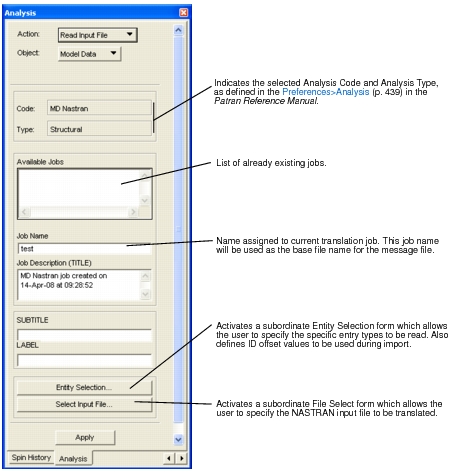
Entity Selection Form
This subordinate form appears when the Entity Selection button is selected on the Analysis form and Read Input File is the selected Action. It allows the user to specify which MD Nastran entity types to import.
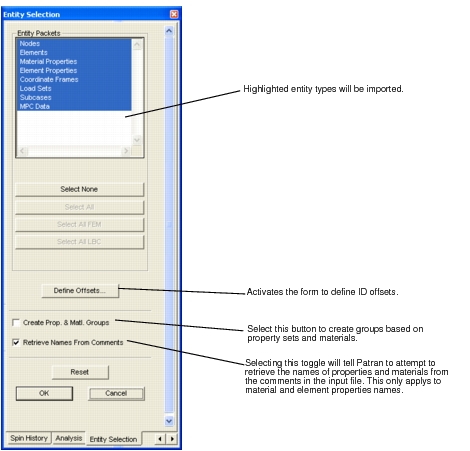
The following table shows the relation between the entity types listed above and the actual MD Nastran entry types effected. If an entity type is filtered out, it is treated as if those entries did not exist in the original input file.
Entity Type | MD Nastran Cards |
Nodes | GRID, GRDSET, SPOINT |
Elements | BAROR, BEAMOR, CBAR, CBEAM, CBEND, CDAMP1, CDAMP2, CDAMP3, CDAMP4, CELAS1, CELAS2, CELAS3, CELAS4, CGAP, CHEXA, CMASS1, CMASS2, CMASS3, CMASS4, CONM1, CONM2, CONROD, CPENTA, CQUAD4, CQUAD8, CQUADR, CROD, CSHEAR, CTETRA, CTRIA3, CTRIA6, CTRIAR, CTRIAX6, CTUBE, CVISC, PLOTEL |
Material Properties | MAT1, MAT2, MAT3, MAT8, MAT9 |
Element Properties | PBAR, PBCOMP, PBEAM, PBEND, PCOMP, PDAMP, PELAS, PGAP, PMASS, PROD, PSHEAR, PSHELL, PSOLID, PTUBE, PVISC |
Coordinate Frames | CORD1C, CORD1R, CORD1S, CORD2C, CORD2R, CORD2S |
Load Sets | FORCE, GRAV,MOMENT, PLOAD1, PLOAD2, PLOAD4, PLOADX1, RFORCE, TEMP, TEMPP1, TEMPRB, SPC, SPC1, SPCD |
Subcases | LOAD, SPCADD, Case Control Section |
MPC Data | MPC, RBAR, RBE1, RBE2, RBE3, RROD, RSPLINE, RTRPLT |
Comment Lines | All items starting with a "$" are added to the imported Job as Direct Text Input. Also unrecognized entries are also imported. Turning this selection OFF will not import any entries begining with a "$", however unrecognized entries will still be imported. To disable import of both the comment lines and the unrecognized entries, use the Define Offsets Form and set the Comment Lines Offset/Maximum to a negative number. Be default only 1000 comment lines and 1000 unrecognized entiries will be imported. The system environment variable PATRAN_DTI_LINE_LIMIT, or a settings.pcl entry pref_env_set_integer("patran_dti_line_limit", <line limit>) can be set, or the value can be changed on the Define Offsets Form. Setting it to zero (0) or AUTO will cause all comments and unrecognized items to be imported. Use caution when doing this as many input decks have thousands of comment lines and this could cause unnecessary bloating of the database and poor performance access to Direct Text Input form. |
It should be noted that since the GRID entry is controlled with the Nodes filter, the grid.ps load set with the permanent single point constraint data will also be controlled by the Nodes filter.
Define Offsets Form
This subordinate form appears when the Define Offsets button is selected on the Entity Selection form. It allows the user to specify the ID offsets used when reading a MD Nastran input file.
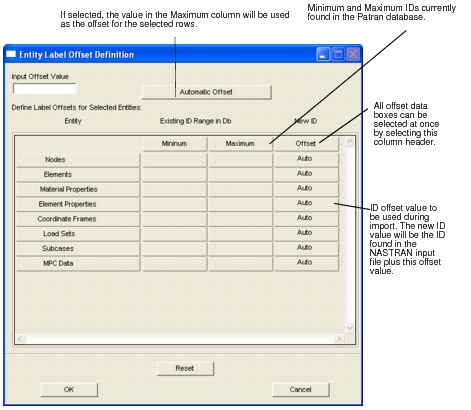
All references made in the input file will also be offset. If a node references a particular CID as its analysis frame, then the reference will be offset as well. If the coordinate frame is defined in the same input file, the proper references should be maintained. The preference will be properly maintained. If the coordinate frame existed in the file prior to the import, then it needs to be the offset CID. If a coordinate frame with that CID is not found in the database, an error message will be issued.
To determine which offset effects a particular MD Nastran entry type, refer to the table in the previous section.
For Patran entities identified by integer IDs (nodes, elements, coordinate frames, and MPCs), the offset value is simply added to the MD Nastran ID to generate the Patran ID.
For Patran entities identified by text names (materials, element properties, load sets, and load cases), the offset value is first added to the MSC⁄Nastran ID. The new integer value is then used to generate the Patran name per the naming conventions described in later sections.
Selection of Input File
This subordinate form appears when the Select Input File button is selected on the Analysis form and Read Input File is the selected Action. It allows the user to specify which MD Nastran input file to translate.
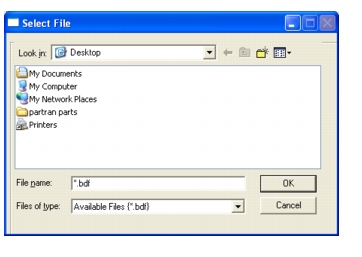
Summary Data Form
This form appears after the import of the NASTRAN input file has completed. It displays the number of entities imported correctly, imported with warnings, or not imported due to errors. These figures reflect the number of Patran entities created. In some cases, there is not a one-to-one relation between the original MD Nastran entities and the generated Patran entities. For example, when material orientations on several CQUAD4s are defined using references to varying MCIDs while still referencing the same PID, Patran needs to create a unique property set for each different MCID reference.
When the OK button is selected, the newly imported data will be committed to the Patran database, and can not be undone. If there is any question as to whether or not this import was desired, review the graphics data prior to selecting OK on this form. If the import was not correct, select the undo button on the main menu bar before selecting OK on this form.
Reject Card Form
During import of the
NASTRAN input file, some entries types might not be understood by Patran. Those entries are brought into Patran in the direct text input data boxes. Selecting the Reject Cards button on the Summary Data form will bring up this Reject Card Form. You can review these entries here.
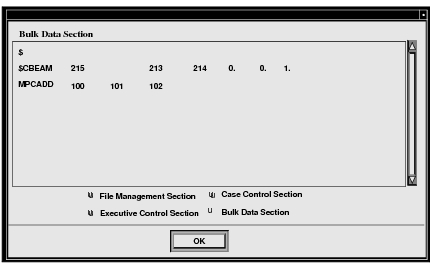
Only entry types not supported by Patran are sent to the reject entry blocks. (This includes comments.) Cards which are otherwise recognized, but can not be imported due to syntax or invalid data errors are not sent to the reject blocks. The rejected entries will have no characters in front of the command name. Commands preceded by the character $> are used by the MSC/AMS product to allow processing of comment lines.
Note: | Rejected cards are placed in the Direct Text Input (DTI) text boxes. If you turn ON the ability to write DTI into the various portions of the MD Nastran input deck, the rejected cards will be placed back into the input deck when it is written out again. |






